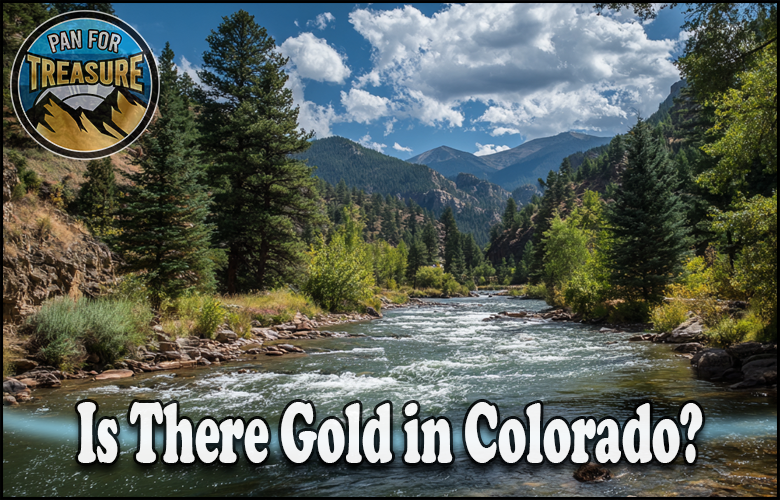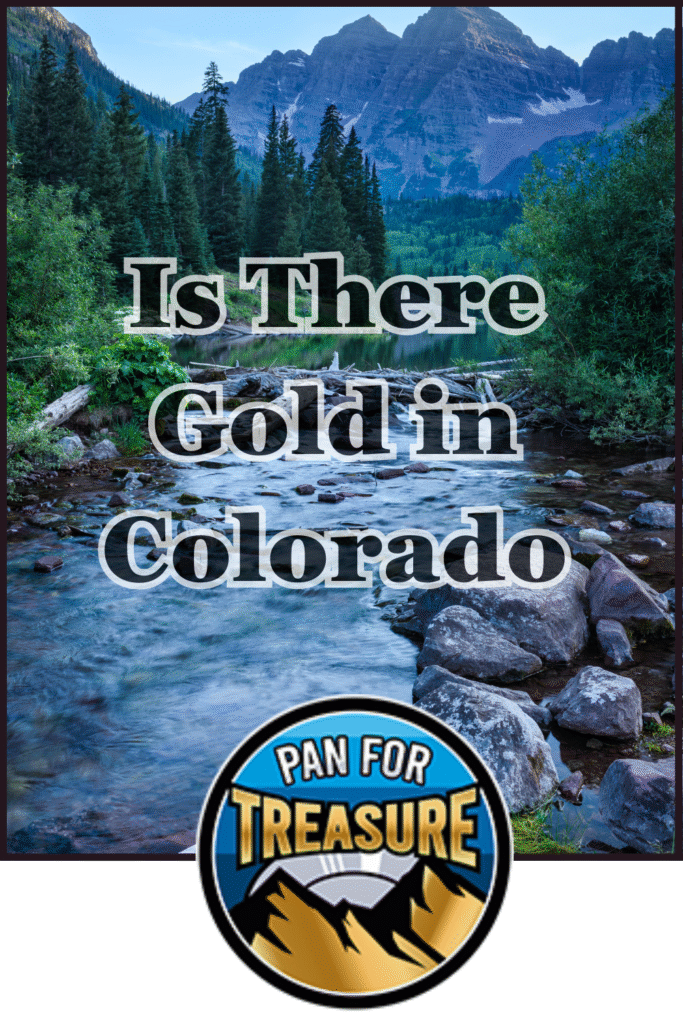
Disclosure: This Post Contains Affiliate Links; We earn a commission on purchases.
Is there gold in Colorado? Absolutely! Beneath its breathtaking landscapes and towering mountains lies a glittering history of gold that has shaped the state’s identity.
From the first gold discoveries near Denver in 1858 to the legendary gold districts like Cripple Creek, Colorado has long been a destination for gold seekers.
This rich history of gold mining has played a pivotal role in the state’s establishment and continues to captivate adventurers and historians alike.
Key Takeaways:
- Gold mining in Colorado dates back to 1858 and has significantly contributed to the state’s development.
- The Colorado Mineral Belt, stretching southwest across the state, is renowned for its gold deposits.
- The Cripple Creek district, located far from the mineral belt, continues to produce gold to this day.
- The Colorado Gold Rush brought thousands of prospectors to the state, leaving a lasting legacy of gold mining.
- Visitors can explore Colorado’s gold mining history through mine tours and recreational gold panning.
Is There Gold in Colorado: A Legacy of Gold Mining
The Colorado Gold Rush, also known as the Pike’s Peak Gold Rush, was a transformative period in the state’s history.
From 1858 to 1861, approximately 100,000 prospectors flocked to Colorado in search of fortune and adventure.
The discovery of gold in the Front Range region sparked a rush of migration, leading to the establishment of large mining camps that eventually grew into cities like Denver and Boulder.
The allure of striking it rich in the mountains brought people from all walks of life to Colorado. Miners, merchants, and entrepreneurs ventured into the rugged terrain in search of precious gold.
With dreams and aspirations of wealth, they worked tirelessly to extract the valuable mineral from the earth.
By the time Colorado achieved statehood in 1876, the state was already dotted with active gold mines in various locations. Places like Leadville, Breckenridge, Central City, Idaho Springs, South Park, and Cripple Creek had bustling gold mining operations.
These areas became emblematic of the Colorado Gold Rush and played a vital role in shaping the state’s economy and identity.
“The Colorado Gold Rush was a pivotal moment in the development of Colorado as a state. It set the stage for the growth of mining towns and the establishment of a mining industry that continues to this day.” – Jane Thompson, Colorado Historian
To this day, the legacy of the Colorado Gold Rush can be explored and experienced through mine tours and hands-on gold panning activities.
These immersive experiences allow visitors to step back in time and gain a deeper understanding of the hardships and triumphs of early gold miners.
| Colorado Gold Mines | Location | Historical Significance |
|---|---|---|
| Cripple Creek | Teller County, Colorado | One of the last gold districts discovered during the Colorado Gold Rush and still active today. |
| Leadville | Lake County, Colorado | Renowned for its rich silver and gold deposits, it was once the second-largest city in Colorado. |
| Breckenridge | Summit County, Colorado | Home to some of the largest gold nuggets ever found in Colorado. |
From the bustling mines in Cripple Creek to the remnants of once-thriving mining towns, Colorado offers a wealth of opportunities to explore and learn about its gold mining history.
Visitors can delve into the past through tours of historic mines such as the Argo Gold Mine in Idaho Springs or the Western Museum of Mining & Industry in Colorado Springs.
Gold Panning: Unearthing History
If you want to experience the thrill of gold prospecting firsthand, Colorado offers abundant opportunities for gold panning.
Along rivers and creeks like the Arkansas River, San Miguel River, and Clear Creek, recreational gold panning is both permitted and popular.
These designated areas provide visitors with the chance to try their luck at finding gold.
By sifting through sediments in the water using a gold pan, you can uncover the same excitement that captivated miners during the Colorado Gold Rush.
While you may not strike it rich, the experience itself is a treasure.
Plan Your Gold Rush Adventure
- Research guided mine tours in Colorado to gain valuable insights into the history and techniques of gold mining.
- Check for recreational gold panning areas along rivers and creeks to try your hand at finding real gold.
- Visit museums and historical sites to deepen your understanding of the Colorado Gold Rush era.
- Consider joining gold prospecting clubs or groups to connect with fellow enthusiasts and learn from experienced prospectors.
Embark on a journey through time and discover the lasting legacy of the Colorado Gold Rush.
Immerse yourself in the rich history, explore the remnants of mining towns, and experience the thrill of gold panning in the beautiful landscapes of Colorado.
Where to Find Gold in Colorado Today
While Colorado has a long history of gold mining, there are still plenty of opportunities for gold prospecting in Colorado.
The Cripple Creek & Victor Gold Mine, located west of Colorado Springs, is the only remaining active large-scale gold mining operation in the state.
Public tours of the mine were previously available, allowing visitors to see the mining process in action.
In addition to active mines, many former mining areas in Colorado have embraced their gold mining heritage with tours and museums, offering visitors a chance to relive the Wild West.
These attractions provide a unique insight into the lives of miners and the challenges they faced during the gold rush era.
For those looking to take their gold prospecting experience to the next level, there are designated areas along rivers and streams where recreational gold panning is allowed.
This provides individuals with the opportunity to try their hand at gold mining in Colorado and potentially find their own valuable nuggets.
These areas are carefully managed to ensure the preservation of natural resources while allowing recreational prospecting.
So whether you want to explore an active gold mine, immerse yourself in the history of Colorado’s gold rush, or try your luck with recreational gold panning, Colorado offers a range of opportunities for both novice and experienced prospectors.
Experience the thrill of searching for gold and uncovering the state’s rich mining heritage. Discover the beauty of Colorado and its abundant natural resources as you embark on your own gold prospecting adventure.
Colorado Gold Mine Tours
One of the best ways to learn about gold mining in Colorado is through guided mine tours. These tours take visitors underground to see the exposed areas where gold veins and other minerals have been discovered and extracted.
Many mine tours also include interactive mining or panning experiences, allowing visitors to try their luck at finding small gold flakes.
Some popular mine tours in Colorado include:
- The Argo Gold Mine in Idaho Springs
- The Western Museum of Mining & Industry in Colorado Springs
- The Bachelor Syracuse Mine Tour in Ouray
These tours provide an educational and immersive experience, giving visitors a glimpse into the life of a gold miner.
Whether you’re a history enthusiast, an adventurer, or simply curious about the mining industry, these tours offer a unique opportunity to explore Colorado’s rich gold mining heritage.
“Gold mining tours in Colorado allow visitors to step back in time and experience the thrill of searching for gold firsthand. It’s an unforgettable adventure that combines education, excitement, and the chance to discover a hidden treasure.” – John Smith, Gold Mining Enthusiast
Gold Panning in Colorado
For those seeking the exhilaration of uncovering gold in its natural environment, Colorado offers numerous opportunities for gold panning.
Take on a thrilling adventure along the picturesque rivers and creeks, such as the Arkansas River, San Miguel River, and Clear Creek, where enthusiasts can indulge in recreational gold panning activities.
To ensure a responsible and legal experience, it is crucial to engage in panning only on public lands and within designated recreational gold panning areas.
Several popular locations exist for gold panning in Colorado. One such spot is the Texas Creek BLM Prospecting Site, situated near Cañon City.
Here, visitors can revel in the breathtaking beauty of the surrounding landscape while enjoying the excitement of panning for gold.
Another notable location is the Point Barr Prospecting Site, located near Pueblo. This picturesque site offers a serene atmosphere for panning, allowing participants to immerse themselves in nature while searching for gold flakes.
A must-visit location for gold panning enthusiasts is the Norwood Bridge Recreational Placer Mining Area near Norwood.
This idyllic setting provides an excellent opportunity to try your luck at finding gold, all while basking in the tranquility of the surrounding environment.
Remember, if larger chunks or nuggets are discovered during your quest for gold, it is advisable to show them to park staff for further guidance and appreciation of your remarkable find.
“Gold panning in Colorado offers an exhilarating and immersive experience, allowing individuals to connect with nature and relive the state’s rich mining history.”
Tips for Successful Gold Prospecting in Colorado
Tips for Successful Gold Prospecting in Colorado
Gold prospecting in Colorado is an exciting adventure, but success often depends on preparation and knowing where to look.
Here are some tips to help you make the most of your search for gold in the Centennial State:
- Research Historical Gold Fields
Colorado’s rich history of gold production offers valuable clues for modern prospectors. Areas like Ralston Creek, Clear Creek County, and Gilpin County were hotspots during the California Gold Rush era and remain promising locations for finding gold dust and placer deposits. - Focus on Rivers and Streams
Many of Colorado’s gold discoveries have been made in stream beds and along riverbanks. The Blue River, Big Bend, and Wheat Ridge are known for their placer deposits, while the San Juan Mountains and Park County also boast significant mineral deposits. - Understand the Geology
Gold is often found in sedimentary rocks, ore bodies, and other geological formations. Familiarize yourself with the types of rocks and mineral deposits common in Colorado’s gold fields, particularly in areas like the Rocky Mountains and Prospecting Park. - Check for Mining Claims
Before you start prospecting, ensure the area is open for recreational gold panning. Many gold-rich areas, such as those in Gilpin County and Park County, may have active mining claims or restrictions. Always respect private property and claim boundaries. - Explore Modern and Historical Techniques
While traditional gold panning is a popular method, open pit mining and other modern techniques have also been used to extract millions of troy ounces of gold from Colorado’s gold fields. Experiment with different tools and methods to increase your chances of success. - Visit Designated Prospecting Areas
Colorado offers several recreational gold panning areas, such as Prospecting Park, where you can legally search for gold. These areas are often rich in placer deposits and provide a great starting point for beginners. - Be Patient and Persistent
Gold prospecting requires time, effort, and a bit of luck. Whether you’re searching for gold dust in a stream bed or exploring the mineral deposits of the San Juan Mountains, persistence is key to uncovering hidden treasures.
By following these tips and exploring Colorado’s diverse gold-rich regions, you can enjoy a rewarding and educational prospecting experience.
With its rich history and abundant gold fields, Colorado remains a top destination for gold seekers.
Gold Panning FAQs for Colorado
Is there gold in Colorado rivers?
Yes, Colorado rivers like the South Platte River, Arkansas River, and Clear Creek have long been known for gold. These rivers were central to the Colorado Gold Rush and are still popular with modern prospectors.
Is there gold in Colorado creeks?
Many creeks in Colorado, especially in the central mountains and Front Range, have produced placer gold. Notable examples include Cache Creek, Clear Creek, and French Gulch near Breckenridge.
Is there gold in Colorado streams?
Yes, streams in historic mining districts across Colorado often carry fine gold and flakes. Prospectors have success working streambeds near Leadville, Idaho Springs, and Fairplay.
Is there gold in Colorado today?
Gold prospecting is still alive and well in Colorado. Recreational panners and small-scale miners continue to find gold using pans, sluices, and dredges in approved locations across the state.
Where can I pan for gold in Colorado?
Great places to pan for gold in Colorado include Cache Creek near Granite, the Clear Creek prospecting area west of Denver, and the Arkansas River around Buena Vista. Make sure to review local regulations and land ownership before panning.
{
“@context”: “https://schema.org”,
“@type”: “FAQPage”,
“mainEntity”: [
{
“@type”: “Question”,
“name”: “Is there gold in Colorado rivers?”,
“acceptedAnswer”: {
“@type”: “Answer”,
“text”: “Yes. Colorado rivers like the South Platte River, Arkansas River, and Clear Creek have long been known for gold. These rivers were central to the Colorado Gold Rush and are still popular with modern prospectors.”
}
},
{
“@type”: “Question”,
“name”: “Is there gold in Colorado creeks?”,
“acceptedAnswer”: {
“@type”: “Answer”,
“text”: “Yes. Many creeks in Colorado, especially in the central mountains and Front Range, have produced placer gold. Cache Creek, Clear Creek, and French Gulch near Breckenridge are notable examples.”
}
},
{
“@type”: “Question”,
“name”: “Is there gold in Colorado streams?”,
“acceptedAnswer”: {
“@type”: “Answer”,
“text”: “Yes. Streams in historic mining districts across Colorado often carry fine gold and flakes. Prospectors find success in streambeds near Leadville, Idaho Springs, and Fairplay.”
}
},
{
“@type”: “Question”,
“name”: “Is there gold in Colorado today?”,
“acceptedAnswer”: {
“@type”: “Answer”,
“text”: “Yes. Gold prospecting is still alive and well in Colorado. Recreational panners and small-scale miners continue to find gold using pans, sluices, and dredges in approved locations.”
}
},
{
“@type”: “Question”,
“name”: “Where can I pan for gold in Colorado?”,
“acceptedAnswer”: {
“@type”: “Answer”,
“text”: “Popular spots include Cache Creek near Granite, the Clear Creek prospecting area west of Denver, and the Arkansas River around Buena Vista. Always review local regulations and land ownership before panning.”
}
}
]
}
Conclusion
Colorado’s gold mining history runs deep, leaving an indelible mark on the state’s identity and culture.
From the Pike’s Peak Gold Rush of the 19th century to modern-day mining operations, the allure of gold continues to captivate adventurers and history enthusiasts alike.
Visitors can immerse themselves in this legacy through guided mine tours, offering a firsthand look at the challenges and triumphs of miners, or by trying their hand at gold panning in Colorado’s rivers and creeks.
These experiences not only connect participants to the past but also highlight the importance of preserving natural resources for future generations.
So, is there gold in Colorado? The answer lies not only in its rivers and mountains but also in the enduring stories and heritage that make the state truly golden.
Source Links
- https://en.wikipedia.org/wiki/Gold_mining_in_Colorado
- https://www.uncovercolorado.com/gold-panning-in-colorado/
- https://cpw.state.co.us/thingstodo/Pages/Gold-Panning.aspx


Meet Ryan Conlon, the passionate owner and driving force behind Pan for Treasure.
With an unwavering love for the art of gold panning, Ryan has transformed his enthusiasm into a thriving community hub for fellow treasure seekers. [email protected]
A seasoned gold panning enthusiast, Ryan’s journey began with a simple pan and a dream, evolving into a deep appreciation for the history, geology, and thrill of uncovering precious metals.
Subscribe to Our Newsletter
